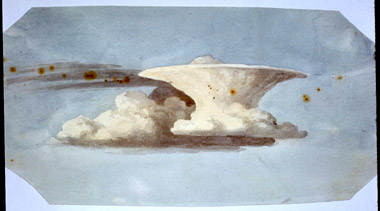We all love to lament about the Weatherman. Although I have only lived in a few other countries, its not hard for me to imagine this is a universal trend.
To be fair, even with the “inexact science” of meterology, it does afford probabilities which help us plan our lives. It also has an impact on industry, public safety, and infrastructure.
The “father” of meterology, Luke Howard, was an amateur sky gazer and professional industrial chemist. He is most remembered for devising a system for naming clouds.
He was also a noted abolistionist and born and bred Londoner.
Born to a lamp manufacturerin 1772, Luke Howard was educated in Oxfordshire at a Quaker school. After matriculation, Howard became a pharmacist apprentice, and then followed that by setting up his own shop in Fleet Street in 1793. In 1797, he partnered with William Allen to form Allen & Howard, a London based pharmaceutical that manufactured aspirin and quinine. This partnership would continue until 1807, and then later become Howard & Sons (1856).
Howard lived to a ripe old age of 92 and died in 1864.
During his time at Allen & Howard, he engaged in his hobby of meteorology. It was in 1802, when he published a paper suggesting the naming of clouds, that he became credited with pushing the young science into solid footing. He would go on to write the first textbook about meteorology.
Howard said the importance of clouds in meteorology was paramount: “Clouds are subject to certain distinct modifications, produced by the general causes which affect all the variations of the atmosphere; they are commonly as good visible indicators of the operation of these causes, as is the countenance of the state of a person’s mind or body.” In essence, he was identifying clouds as the symptom of atmospheric processes.
Howard’s famous entree into weather comes when he was eleven, during the “Great Fogg” of 1783. Dust and ash from volcanic eruptions in Iceland and Japan created a hazy ash pall across the skies which fascinated the young man.
Ever after, he immersed himself in the study of atmospheric science. He would augment observations with barometer and thermometer readings, until he had a rich data set of correlations. Building on the first cloud classification system by French scientist Lamarck, Howard would later reflect about his cloud classification:
“The names … were intended as arbitrary terms for the structure of clouds, and the meaning of each was carefully fixed by a definition … (Local terms) take away from the nomenclature its present advantage of constituting … an universal language, by means of which the intelligent of every country may convey to each other their ideas without the necessity of translation. And the more this facility of communication can be increased, by our adopting by consent uniform modes, terms, and measures for our observations, the sooner we shall arrive at a knowledge of the phenomena of the atmosphere in all parts of the globe, and carry the science to some degree of perfection.”
Luke Howard's sketch of cumulus clouds
Luke has a collection available broadly on the WWW of sketches of clouds, for those who are interested in art, atmospheric science or history. This, along with his measurement of weather patterns, helped him produce the The Climate of London which tracked cloud relationship to weather.
Howard’s partner, William Allen, was also a Quaker and abolitionist. Howard was a long standing member of the Society of Friends until 1837 when a schism in the movement made him convert to Plymouth Brethren.
For more about Howard, check out this book: http://www.amazon.com/Invention-Clouds-Amateur-Meteorologist-Language/dp/0374177155

Howard Sketch of anvil clouds












